
Is the auto industry wasting money on mobility / autonomy / electric?
This week we released the findings of research surveying more than 10,000 consumers internationally (USA, UK, France, Germany and China) about how they really feel about the big changes in cars (mobility, electric, autonomous).
The hype about disruption on multiple fronts in automotive is significant – and the level of investment going into new trends by OEM and others is significant. Our research indicates that consumer appetite and the speed of change differs hugely by region and overall is likely to be slower than hyped.
China leads the pack on every measure with high consumer willingness to consider all the new trends in automotive – with >90% stating they will consider an electric/hybrid vehicle at next replacement, >90% prepared to consider mobility alternatives to ownership, and >70% keen to try autonomous vehicles when they are available.
In more mature markets (UK, USA, France, Germany) the attachment to individual cars is strong, even amongst “generation rent” 18-29 year old millenials e.g. 73% of USA 18-29 year old drivers see having your own car as “essential” to getting around. The private car looks to be around for a long while and the openness to new models of mobility is low (<10%) partly for structural reasons as 50% of journeys are at peak times when car sharing will represent some challenges. Where it resonates is young, urban, family free consumers, who are a minority of the market today.
Consumers are however increasingly open to electric and hybrid, particularly in France where 46% expect to consider an EV/Hybrid next time they replace their vehicle. Consumers remain distrustful of Autonomous vehicles (60-70% of EU and USA consumers would not want to try one).
Where they are changing significantly is in wanting simple monthly access to bundled services to cover their motoring needs without them taking on the risk of ownership or the hassles of managing the vehicle. In essence they don’t want to have to be a one-person fleet manager for their car and would like buying a car to be more like other consumer services e.g. a mobile phone contract.
The coming adoption of electrified vehicles could be a catalyst – as consumers will be even more reticent to take on the uncertain risks of battery life and residual value – and providers will be able to take advantage of longer lifecycles as electrical motors and transmission are typically simpler and more reliable than combustion equivalents.
This is a huge opportunity for the industry – where there is risk transfer and convenience there is usually a premium. For a historically ‘cost-plus’ industry this could be a welcome boost. All the tricks and strategies for pricing and segmentation developed in retail and leisure will become increasingly attractive to deploy.
The fly in the ointment is no single provider has all the ingredients of the puzzle, although OEM finance captives probably have a head-start. Car markers, dealers and service providers across the lifecycle of a car will have to work together and need software and connectivity to deliver the products consumers want.
Anyone involved in vehicle distribution and services today needs an answer as to where they fit into this future and how.
Contact our experts to discuss our findings.



